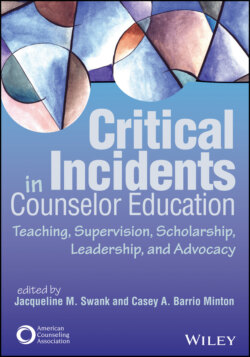Читать книгу Critical Incidents in Counselor Education - Группа авторов - Страница 83
Critical Incident Response
ОглавлениеJonathan H. Ohrt and Kathryn P. Linich
The timing of this incident presents a significant challenge, as the end of the semester is typically focused on wrapping up content and processing learning and experiences. Nevertheless, the instructors made a sound decision to address cohort dynamics and concerns around multicultural and social justice counseling competencies. This response focuses on the initial conversation, cohort support, and programmatic implications.
Consistent with their constructivist, student-centered approach, the instructors did a good job facilitating open and honest discussion. To prepare for the conversation, they might have assigned some brief readings that address privilege, oppression, and experiences of students in counseling programs (e.g., Paone et al., 2019). The instructors could model disclosure and vulnerability by acknowledging their own biases and blind spots with the class (Pulliam et al., 2019). For example, the video likely included an effective intervention; however, Black students may have been frustrated by not learning from a Black counselor. The instructors could acknowledge that some curricula are still colonized, validating Black students’ feelings of anger and frustration (Haskins et al., 2013). In the future, the instructors could further decolonize materials so students are able to hear Black, Indigenous, and people of color (BIPOC) perspectives in readings, case examples, and videos.
The instructors did well to honor the needs of the cohort and focus on unfinished business in the last class. This reinforced the expression of concerns as well as productive and honest discussion. Structuring the class around how to have a respectful and progressive discussion of multicultural issues provided a substantive opportunity for professional development, and these instructors made it clear to their students that they were invested. Having a safe and nonjudgmental environment in which to reflect on difficult topics aided Amy’s growth and that of the cohort overall. The activity Jessica and Veronica used and other service-learning activities could be incorporated into the curriculum more regularly in other classes, such as classes on ethics, multicultural counseling, and group work (Langellier et al., 2020). Because the students were in a cohort, the instructors could have further developed a plan to continue to address unresolved issues as the students transitioned to the next internship.
Although this case is specific to a course, the cohort tension that emerged indicates that more systemic program dynamics are present. The instructors handled their concerns about Amy in a fair and ethical way through consultation with faculty and discussion. It could be helpful to review program policies and practices to ensure the perspectives of minoritized students are heard. For instance, program faculty members could develop an advisory committee. The program could also review all courses to ensure diversity concepts are reinforced and multicultural and social justice counseling competencies are included in coursework. Finally, faculty members could engage in continuous professional development to increase their awareness of diversity in higher education and improve their ability to build relationships with BIPOC students (Haskins et al., 2013; Pulliam et al., 2019).
It appears that this concern has been simmering over the course of these students’ graduate studies with no real outlet. The key to encouraging multicultural and social justice counseling competencies in all students is to integrate them into professional identity development early and often (Decker et al., 2016). The program may find ways to facilitate these conversations and integrate opportunities for advocacy from the first semester of classes, with continued check-ins throughout the course of the program. This would encourage students to have these conversations more openly and avoid a situation like the one discussed in this case. This could also be accomplished by assigning advocacy work, reflective exercises, experiential learning, and service learning (Decker et al., 2016; Langellier et al., 2020). Infusing social justice and advocacy into counseling courses could also help faculty notice discrepancies in development, such as the behaviors and beliefs demonstrated by Amy. In these ways, program faculty members can recognize and address student- and program-level concerns earlier and more proactively.
• • •
